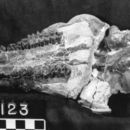Multituberculates (Multituberculata)
provided by EOL authors
The Order Multituberculata was named by Cope in 1884. This successful, diverse group of rodent-like mammals existed for @ 120 million years [3] from the Jurassic, or perhaps even the Triassic to the early Oligocene, 35 million years ago after being outcompeted by rodents [1,3]. Multituberculates are usually placed outside either of the two main groups of living mammals—Theria, including placentals and marsupials, and Monotremata[3]. They are probably closer to Theria than to monotremes.[4][5]
At least 200 species and about 80 genera of Multituberculata are known..are known, ranging from mouse-sized to beaver-sized. They occupied diverse ecological niches, from burrow-dwelling to squirrel-like arborealism [2]. They are mostly known from the northern continents (Laurasia), but there are some records, many of which are controversial, from the southern continents (Gondwana). The group Gondwanatheria, known from Argentina, Antarctica, Madagascar, India, and possibly Tanzania, has been referred to the order in the past, but this is controversial. Two genera, Hahnodon and Denisodon, from the Early Cretaceous of Morocco, may be haramiyidans instead. Multituberculates have also been recorded from the Late Cretaceous of Madagascar and Argentina [6]. An Australian multituberculate, Corriebaatar, is known from one tooth [7]. In the late Cretaceous, multituberculates were widespread and diverse in the northern hemisphere, making up over half the mammal species of typical land mammalian species were multituberculates While some lineages became extinct during the faunal turnover at the end of the Cretaceous, multituberculates successfully crossed the Cretaceous–Paleogene boundary and reached their peak of diversity in the Paleocene, ranging from the size of a very small mouse to that of a beaver. They were an important component of nearly all Paleocene faunas of Europe and North America and some late Paleocene faunas of Asia. .
Multituberculates had a cranial and dental anatomy similar to rodents, with cheek-teeth separated from the chisel-like front teeth by a wide tooth-less gap (diastema). Each cheek-tooth had several rows of small cusps (or tubercles, hence the name) that operated against similar rows in the teeth of the jaw. As in modern rodents, this masticatory apparatus formed an efficient chopping device.[3]
In the Cretaceous and Paleocene, the multituberculates radiated into various morphotypes, including squirrel-like arboreal ptilodonts. Their last lower premolars were larger and more elongated than the other cheek-teeth and had an occlusive surface forming a serrated slicing blade. It was probably used to crush seeds and nuts, but it is believed that most small multituberculates supplemented their diet with insects, worms, and fruits [3]. The pelvic structure suggests that multituberculates gave birth to tiny helpless, underdeveloped young, similar to modern marsupials.[2][8]
Kielan-Jaworowska and Hurum [7] found that most multituberculates could be referred to two suborders: Plagiaulacida and Cimolodonta, but the Arginobaataridae (Arginbaatar) shares characteristics with both groups. The suborder "Plagiaulacida" is a paraphyletic group, named by Simpson in 1925. It represents the more primitive evolutionary grade. Its members are the more basal Multituberculata, such as Glirodon. They ranged from perhaps the middle Jurassic until the lower Cretaceous. They include the Families Paulchoffatiidae (Subfamilies Paulchoffatiinae and Kuehneodontinae), Hahnodontidae, Pinheirodontidae, Allodontidae, Zofiabaataridae, Plagiaulacidae, Eobaataridae and Albionbaataridae. The group is subdivided into three informal groupings: the Allodontid, Paulchoffatiid and Plagiaulacid lines. The suborder Cimolodonta seems to be a natural (monophyletic) suborder, named by McKenna in 1975. It includes the more derived Multituberculata from the lower Cretaceous to the Eocene. It includes Ameribaatar, Ptilodus, Uzbekbaatar and the Paracimexomys group, as well as the Families Boffidae and Cimolomyidae [9]. The Superfamily Ptilodontoidea includes Neoliotomus and the Families Cimolodontidae, Neoplagiaulacidae, Ptilodontidae, Eucosmodontidae and Microcosmodontidae. The Superfamily Djadochtatherioidea includes Bulganbaatar, Chulsanbaatar and Nemegtbaatar and the Families Sloanbaataridae and Djadochtatheriidae. The Superfamily Taeniolabidoidea includes the Family Taeniolabididae.

